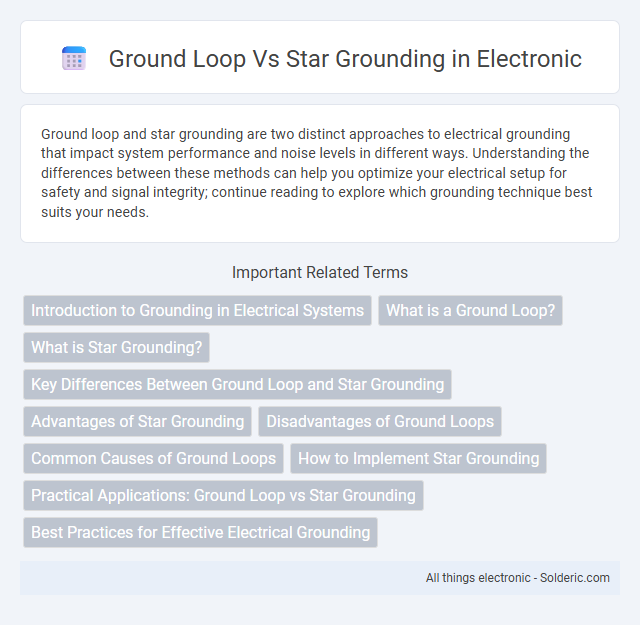Ground loop and star grounding are two distinct approaches to electrical grounding that impact system performance and noise levels in different ways. Understanding the differences between these methods can help you optimize your electrical setup for safety and signal integrity; continue reading to explore which grounding technique best suits your needs.
Comparison Table
| Feature | Ground Loop | Star Grounding |
|---|---|---|
| Definition | Unintended current path causing noise and interference | Single grounding point connecting all grounds centrally |
| Cause | Multiple grounding paths creating loops | Deliberate central grounding design |
| Noise Susceptibility | High, due to induced loop currents | Low, reduces interference by avoiding loops |
| Application | Generally undesired in audio, power, and signal systems | Preferred in sensitive electronic and audio systems |
| Complexity | Can complicate troubleshooting | Simplifies grounding layout and maintenance |
| Effect on Signal Integrity | Degrades signal quality, causes hum and buzz | Maintains clean signals with minimal interference |
| Implementation Cost | Low initial but costly troubleshooting | Moderate, with long-term reliability benefits |
Introduction to Grounding in Electrical Systems
Grounding in electrical systems ensures safety by providing a reference point for voltage levels and a path for fault currents. Ground loops occur when multiple grounding paths create unintended current flow, causing noise and interference in sensitive equipment. Star grounding minimizes these issues by using a single central ground point, enhancing the stability and performance of your electrical installations.
What is a Ground Loop?
A ground loop occurs when multiple paths to ground create unintentional current flow, causing noise or hum in audio and electronic systems. Star grounding uses a single central grounding point to prevent these loops, ensuring cleaner signal integrity and reducing interference. Understanding ground loops helps you design circuits that minimize unwanted noise and improve overall system performance.
What is Star Grounding?
Star grounding is a wiring method where all ground connections converge at a single central point, minimizing ground loops and interference. Each device or component connects independently to this central ground, ensuring a stable reference voltage throughout the system. This technique reduces noise and helps maintain signal integrity in sensitive electronic circuits.
Key Differences Between Ground Loop and Star Grounding
Ground loop occurs when multiple grounding paths create unwanted current flow, causing noise and interference in audio or electronic systems, while star grounding uses a single, central grounding point to minimize these issues. The key difference lies in how grounding connections are configured; ground loops form loops that pick up electromagnetic interference, whereas star grounding isolates each ground return to a central hub, reducing noise potential. Understanding these differences helps you design effective grounding systems that prevent signal degradation and improve overall performance.
Advantages of Star Grounding
Star grounding offers superior noise reduction by providing a central reference point, minimizing ground loops that can cause interference in audio, video, and sensitive electronic systems. This method enhances signal integrity by ensuring each component has a direct, low-impedance path to the common ground, reducing the risk of ground potential differences. Your system benefits from improved reliability and easier troubleshooting due to the clear and organized grounding structure inherent in star grounding.
Disadvantages of Ground Loops
Ground loops create unwanted noise and hum in audio and electrical systems due to multiple grounding paths causing interference currents. These loops can degrade signal quality, induce electromagnetic interference (EMI), and complicate troubleshooting by masking the actual source of faults. Unlike star grounding, which provides a single, centralized ground point minimizing potential differences, ground loops often result in voltage differentials that damage sensitive equipment.
Common Causes of Ground Loops
Common causes of ground loops include multiple grounding paths creating unintended current flow, differences in ground potential between interconnected equipment, and improper bonding of electrical components. Ground loops often occur when devices are connected through various grounding points, leading to interference and noise in audio, video, or data systems. Star grounding minimizes these issues by centralizing the ground connection, ensuring a single reference point and reducing voltage differentials.
How to Implement Star Grounding
To implement star grounding, connect all ground wires individually to a single central grounding point, creating a radial pattern that minimizes ground loop noise and interference. Use thick, low-resistance conductors to ensure a stable reference potential and reduce voltage drops caused by current flow in the grounding system. Your setup benefits from isolating each circuit's ground path, which maintains signal integrity and improves overall electromagnetic compatibility.
Practical Applications: Ground Loop vs Star Grounding
Ground loop and star grounding techniques differ significantly in practical applications, affecting noise reduction and system stability. Ground loops often occur in audio and instrumentation systems where multiple grounding paths create interference, while star grounding is preferred in sensitive electronics and control panels to minimize electromagnetic interference by having a single grounding point. Your choice between these methods impacts signal integrity and overall system performance.
Best Practices for Effective Electrical Grounding
Effective electrical grounding requires understanding the difference between ground loop and star grounding techniques. Ground loops often cause unwanted noise and interference in audio and sensitive electronic systems, while star grounding minimizes these issues by connecting all grounds to a single central point, ensuring a clear return path and reducing potential voltage differences. To optimize your system's performance, implement star grounding practices, maintain short, low-impedance ground connections, and avoid creating closed loops that could induce interference.
ground loop vs star grounding Infographic

 solderic.com
solderic.com